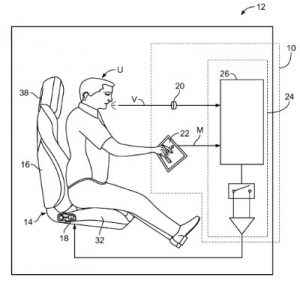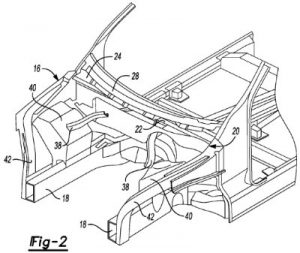 On December 9th, Dearborn, MI-based automaker Ford Motor Company (NYSE:F) issued a press release, which heralded the 1,442 patents granted to the company by the U.S. Patent and Trademark Office during 2016, a total which Ford says is the most among any automaker filing for U.S. patents that year. That total marks the largest number of U.S. patents awarded to Ford in any one calendar year, a 25 percent increase over 2015 which was itself a record year for Ford patent application filings. Globally, Ford received 3,200 patents grants during 2016.
On December 9th, Dearborn, MI-based automaker Ford Motor Company (NYSE:F) issued a press release, which heralded the 1,442 patents granted to the company by the U.S. Patent and Trademark Office during 2016, a total which Ford says is the most among any automaker filing for U.S. patents that year. That total marks the largest number of U.S. patents awarded to Ford in any one calendar year, a 25 percent increase over 2015 which was itself a record year for Ford patent application filings. Globally, Ford received 3,200 patents grants during 2016.
In 2015, Ford received the 27th-most number of U.S. patent grants with 1,199 patents issued by the USPTO, according to information published by the Intellectual Property Owners Association (IPO). That total marked a massive 49.1 percent increase over the number of U.S. patents issued to Ford during 2014, so major year-over-year increases in research and development investments are clear to see in this case. A jump up to 1,442 U.S. patents would have only pushed Ford to 24th overall during 2015, but it would have moved much closer to high tech firms such as Hewlett-Packard Company (1,452 U.S. patents in 2015), Fujitsu Ltd (TYO:6702; 1,455 patents) and Panasonic (TYO:6752; 1,474 patents).
Many other statistics announced by Ford in press releases underscore this narrative that Ford is doing a much better job of embracing innovation. The nearly 6,000 inventions submitted for patent consideration by Ford employees in 2015 was a 26 percent increase over 2014’s invention totals. In 2016, more than 8,000 inventions were disclosed to Ford by employees, a 40 percent increase over 2015’s totals and a 90 percent increase from 2014. There were 5,500 Ford employees submitting inventions to the company during 2016, 2,200 of those being first-time inventors. Ford also claims 4,000 first-time inventors working at the company since the beginning of 2015.
Ford’s press release identifies a few technologies which the company is exploring more thoroughly, leading to the higher levels of patent application filings. For example, Ford has been working on a system involving drones which have sensors installed for digitally mapping an area surrounding an autonomous car. The drones would be able to detect driving conditions for an area beyond what the car itself could detect using its own sensors. These drones could even help enable off-road driving for autonomous vehicles, a feat which is difficult to accomplish due to the unmapped nature of such environments.
Autonomous technologies developed by Ford are also supporting an important accessibility technology invented by the automaker’s employees this year. In November, Ford announced three finalists for the company’s “Last Mile Mobility Challenge,” a Ford initiative designed to encourage the development of mobility technologies. One of those finalists was the eChair, an autonomous wheelchair which will load itself into a compatible trunk after a user has boarded the car. When the car reaches its destination, the eChair will autonomously return to the user’s door for an easy transfer.
Another one of the mobility contest finalists receiving some serious consideration from Ford is the Carr-E, a personal transportation device which resembles a Segway missing its handlebar shaft. The device weigh 25 pounds, has four wheels and can carry a 270-pound load up to 14 miles at a top speed of 11 miles per hour on a full charge. Users can ride the Carr-E or load the transportation with items and follow behind at a maximum distance of almost 30 feet thanks to a wireless sensor device. The Carr-E is the brainchild of German engineer Killian Vas, highlighting Ford’s global investments in R&D.
Ford is even interested in getting involved in the clean water technology space, as is evidenced by the development of On-The-Go H2O. This system is designed to capitalize on the condensation which is naturally created by a auto’s air conditioning system. Instead of expelling the water on the ground the way most cars currently do, Ford cars outfitted with On-The-Go H2O would have a filtration system that can clean water and distribute it to a faucet found within a car’s cabin.
These above innovations are discussed in Ford’s recent press release on its own U.S. patent record but news on other inventive developments have been released in recent days. This January will see the unveiling of a Fusion Hybrid autonomous development vehicle which will be debuted at both the Consumer Electronics Show in Las Vegas and the North American International Auto Show in Detroit. The new development model includes upgraded hardware for a wider field of vision for car sensors which have to identify obstacles in the car’s path. On January 3rd, Ford announced that it would ramp up the global production of electric vehicle (EV) versions of certain models supported by a $700 million investment in the company’s Flat Rock assembly plant, which the company believes will create 700 jobs for producing EVs and autonomous cars.
 Patent applications filed by Ford and published recently by the USPTO continue to unveil Ford’s high tech vision for its own future. U.S. Patent Application No. 20160379491, titled Method and Arrangement for Routing Vehicles in Road Traffic, discloses a method of routing traffic involving a central routing unit which transmits traffic-related data collected from vehicles to other vehicles for improved calculations of optimal navigational routes based on accident data or other information. U.S. Patent Application No. 20160379631, entitled System and Methods for Voice-Controlled Seat Adjustment, discloses a control system for a vehicle including voice and touchscreen input devices and a controller programmed to interpret an adjustment command from a voice command
Patent applications filed by Ford and published recently by the USPTO continue to unveil Ford’s high tech vision for its own future. U.S. Patent Application No. 20160379491, titled Method and Arrangement for Routing Vehicles in Road Traffic, discloses a method of routing traffic involving a central routing unit which transmits traffic-related data collected from vehicles to other vehicles for improved calculations of optimal navigational routes based on accident data or other information. U.S. Patent Application No. 20160379631, entitled System and Methods for Voice-Controlled Seat Adjustment, discloses a control system for a vehicle including voice and touchscreen input devices and a controller programmed to interpret an adjustment command from a voice command  and drive an adjustment actuator to change the position of a movable seat portion. Ford’s even looking at ways of reducing pedestrian injury during accidents, as is reflected by the filing of U.S. Patent Application No. 20160375855, titled Cantilevered Windshield Support for Pedestrian Protection. It would protect a vehicle with a vehicle frame with a cowl box and cowl top panel attached to the windshield with a cantilevered support in such a way that increases the performance of the cowl in preventing injury to pedestrians.
and drive an adjustment actuator to change the position of a movable seat portion. Ford’s even looking at ways of reducing pedestrian injury during accidents, as is reflected by the filing of U.S. Patent Application No. 20160375855, titled Cantilevered Windshield Support for Pedestrian Protection. It would protect a vehicle with a vehicle frame with a cowl box and cowl top panel attached to the windshield with a cantilevered support in such a way that increases the performance of the cowl in preventing injury to pedestrians.

![[IPWatchdog Logo]](https://ipwatchdog.com/wp-content/themes/IPWatchdog%20-%202023/assets/images/temp/logo-small@2x.png)

![[Advertisement]](https://ipwatchdog.com/wp-content/uploads/2024/04/Patent-Litigation-Masters-2024-sidebar-early-bird-ends-Apr-21-last-chance-700x500-1.jpg)

![[Advertisement]](https://ipwatchdog.com/wp-content/uploads/2021/12/WEBINAR-336-x-280-px.png)
![[Advertisement]](https://ipwatchdog.com/wp-content/uploads/2021/12/2021-Patent-Practice-on-Demand-recorded-Feb-2021-336-x-280.jpg)
![[Advertisement]](https://ipwatchdog.com/wp-content/uploads/2021/12/Ad-4-The-Invent-Patent-System™.png)







Join the Discussion
No comments yet.